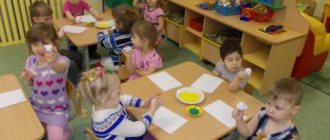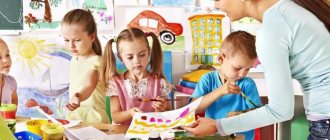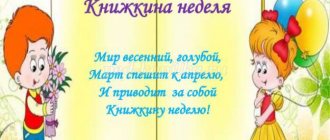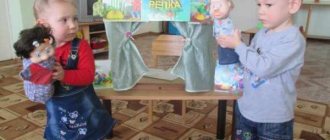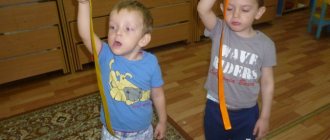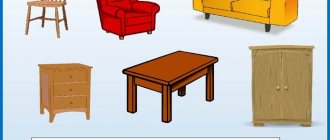Environmental project in kindergarten. Second junior group
Experimental research project for junior group 2 “Nature is our home.
There is no need for garbage in it!” Motto: We want the earth to bloom, And babies to grow like flowers. So that ecology becomes for them. Not science, but part of the soul PROJECT PASSPORT Type of project: information and research Content: children and nature conservation Project participants: children - teachers - parents Number of participants: collective Duration of project implementation: Long-term (September 2016 - May 2022) Problem: pollution of nature with household waste Hypothesis: what will happen to the environment if garbage is not recycled for reuse. 1. Relevance of the problem : By decree of the President, 2017 in Russia has been declared the year of ecology, which is especially important for us, since one of the areas of our kindergarten is environmental education. The work is carried out in the following areas: 1. Nature to man (where children's attention is focused on the aesthetic and health-improving significance of nature). 2. Man - nature (where positive and negative human activities are shown). 3. How to preserve nature (where children learn about the rules of nature conservation). 4. We are defenders of nature (participation in environmental activities). Man cannot live without using the resources of nature. And it is ecology that teaches how to use nature without causing damage to it. Most preschoolers love to walk in nature, go with their parents to the park, river, and go on excursions. But what upsets everyone is that there is a lot of garbage almost everywhere. The children began to wonder: Where does so much garbage come from? How garbage affects nature. Where is the garbage taken? Is it possible to make something useful and beautiful out of garbage? To answer these childish questions and try to solve the “garbage problem,” we developed the project “Nature is our home. There is no need for garbage in it!” 2. Project goal: 1. Finding out the reasons for the appearance of garbage; 2. Conducting an experiment “How garbage decomposes”; 3. Study of methods of sorting, processing and disposal of waste; 4. Carrying out the campaign “Collecting waste paper”, “Second life of things”, “Garbage collection”. Project objectives: To give children an idea of the types of household waste and their properties; about the danger of household waste to human life and living organisms. To clarify children’s ideas about the main sources of land, water, air pollution, its consequences, and measures to prevent pollution. Find ways to reuse household and household waste. To foster an active citizenship in protecting the environment, to expand children’s knowledge about the interdependence of the natural world and human activities, and the desire to communicate with nature without polluting it. To stimulate interest in research activities, to experimentally identify which waste decomposes faster, to improve the ability to operate with existing knowledge, to generalize, to draw conclusions Stages of project implementation Stage I - preparatory 1. Collection and analysis of literary sources on the topic. 2. Design of didactic materials in accordance with the project plan. 3. Questionnaire “Garbage in our city.” 4. Development of tips for parents “How to handle waste at home?” Stage II - organizational 1. Conduct conversations, classes, games to study the properties and qualities of materials: glass, plastic, metal, paper, rubber. 2. Introduce children to the problem of environmental pollution by household waste near their home, on their street, in kindergarten. 3. Conduct an experiment “What does the earth “eat”, and why does it get sick?” Stage III – practical activity 1. Reading S. Mikhalkov’s “Walk”, A. Anishin’s “At the city cleanup”, E. Smirnov’s “Let’s decorate the earth.” 2. View the slide show “Garbage pollutes our nature”
3. Watching a cartoon from the “Smeshariki” series - “About a cow, which, due to poisoning of the air and water, gave gasoline instead of milk,” “The Life of Garbage,” “The Adventure of Leopold the Cat and His Friends in the Yard.” 4. Conversation “Garbage underfoot is dangerous.” Purpose: To provide an understanding of the dangers of garbage to nature and humans. 5. Didactic game “Sorting Garbage” Purpose: to distinguish and name materials, to form an idea of environmental protection through the rational use of unnecessary items and their recycling.
6. S/R game “Going shopping” Purpose: To teach how to choose goods in reusable packaging
7. Thematic observations. For several days, we drew the children's attention to the fact that we throw out garbage every day. Where does he go? What do parents do with garbage? How do you deal with waste in kindergarten? Is it possible to see trash in the vicinity of the kindergarten? Where does it come from? Are there trash cans and trash cans near the garden?
8. Experimental and practical activities. Goal: to help children understand that they should not litter. This affects nature and human health. Learn to use unnecessary items. Using them to create toys, interior decorations, and playgrounds. Paper and cardboard can be taken to recycling centers, where it is turned into new albums, packaging boxes, napkins, wrapping paper and toilet paper. a) Experiments with objects made of different materials (Glass, iron, paper, rubber, plastic). Goal: to experimentally establish the shape, color, properties, methods of their use. b Experiment “Making new paper.” Purpose: To show that even at home, pieces of paper can be reused.
c) Experience “Where does garbage come from and where does it go?”, preschoolers found out where garbage comes from and where it goes. Children threw garbage at home and in kindergarten into a bag. Then they took it to a container on the street and saw that a garbage truck was emptying the container and taking it to a special landfill. The children learned that people do not live near special landfills, because there are a lot of microbes, poisonous gases, and heavy metals there. All this has a detrimental effect on human health and the environment. Therefore, you cannot throw out garbage anywhere, or make unauthorized dumps in forests, ponds, or fields. d) Experience “What the earth “eats” and what makes it sick”, the students decided to find out whether garbage disappears in nature or remains forever. In the fall, in September, the children, together with the teacher, buried some types of household waste (paper, plastic cup, metal can, glass, pieces of wood, leaves) on the territory of the kindergarten and put up signs. In May of the following year, having dug up the garbage, the preschoolers found out that food waste and leaves, pieces of wood had disappeared, but a plastic cup, a metal can, glass, and paper remained in the ground in the same condition. As a result of the experiment, the students concluded that after outdoor recreation, food waste can be buried, and everything else should be collected and thrown into a special container.
d) Experience “How to reduce the amount of waste?” During conversations on the topic “Garbage must be separated,” the students learned that some waste can be recycled; to do this, they just need to sort the garbage at home and take it to special points. 1.The first solution to the problem was waste sorting. Children, with the help of adults, sorted garbage for its subsequent recycling and found possible options for recycling garbage, taking into account the least harm to nature and people 2. The second option for solving the problem was proposed by adults to use things and objects economically. For example, you can write and draw on two sides of a sheet, on the second side of a written sheet. 3.The next solution to the “Buy wisely” was suggested by the pupils’ grandmothers. This means that when you go to the store, you can take bags from home, select and buy shelf-stable products without unnecessary packaging. A clear confirmation of the correctness of this approach was the role-playing game “Shopping for groceries?” The children split into two groups to go grocery shopping. Participants in the first group took shopping containers with them: glass jars, bags, and tried to choose the right products in reusable packaging (glass jars, plastic boxes), while participants in the second group bought all products in disposable packaging. Upon returning home, the participants in the second group unpacked the groceries and threw away the packaging material. As a result, their trash can was full, unlike the bin of the first group of children.
Using food waste to feed animals and fertilize the land.
5. And finally, the most creative solution to the problem is “Second Life”. As a rule, over time, some things become unnecessary, and the only way to get rid of them is to throw them away. But this is not the best option. You can use things to throw away to make toys, gifts or interior items: panels of dried flowers (on candy boxes), paper baskets, gift boxes, attributes for role-playing games, interior design of playgrounds for walks, material for experiments and experiments in a corner of nature.
9. Questioning parents. Of the 20 parents surveyed, 70% accumulate the largest amounts of paper and plastic waste per week, 25% accumulate food waste, and 5% accumulate glass and batteries. 80% do not sort waste and throw it in trash cans. And 20% are sorted, selecting food waste for feeding pets. Only 10% of respondents use unnecessary items for crafts with children and design of their yard. 90% know the dangers of household waste. Only 15% tell children about the dangers of household waste. 50 50% then pick up trash after walks in nature. 30% involve children in cleaning the area near their home and picking up trash after themselves. 65% are not satisfied with the organization of household waste disposal in our city. 10.Environmental campaign “Let’s give nature purity!” 11. Exhibition “Miracles for people from unnecessary things” CONCLUSION: 1. Reading fiction, didactic, role-playing games, excursions to the park, helped preschoolers realize the seriousness of the garbage problem 2. As a result of research activities and observations, we came to the conclusion that waste of artificial origin litters the environment, it must be collected in specially designated places (garbage cans, etc.) or used as recyclable materials for making crafts from waste material. 3. We expanded preschoolers’ knowledge about the dependence of the natural world and people, preschoolers learned about the possibility of recycling waste, and experimented. Now they want to be more careful about nature, to preserve and protect it. Literature: 1. Aksenova, Z.F. Enter nature as a friend. Environmental education of preschool children. – Moscow: Sphere shopping center, 2011. – 128 p. – (Teacher's Library). 2.Andrienko, N.K. Game in environmental education of preschoolers // Preschool pedagogy. - 2007. - No. 1. - P.10-12. 3. Voronkevich, O.A. “Welcome to ecology” - modern technology of environmental education for preschool children // Preschool pedagogy. - 2006. - No. 3.- P. 23-27. 4 Nikolaeva S.N. Young ecologist: Program for environmental education of preschoolers. – M.: Mozaika-Sintez, 2004. 5. Nikolaeva, S.N. Environmental education of younger preschoolers. A book for kindergarten teachers. - M.: Mozaika-Sintez, 2004. - 96 p. 6. Ryzhova N. “Our home is nature.” Program for environmental education of preschool children // Preschool education. 1998. No. 7. pp. 26–34.
We recommend watching:
An environmental project in a kindergarten in an early age group A project in the junior group of a kindergarten on environmental education An environmental project in the second junior group of a kindergarten “Tales from the Garden” Poems on ecology for older preschoolers 6-7 years old
Similar articles:
Scenario of the city festival of children's creativity
Game program on ecology for preschoolers
Ecology project “Seasons”, second junior group
Project “Seasons” Second junior group “FAIRY TALE” (children age 3-4 years)
“We are the masters of our nature, and for us it is a storehouse of the sun with great treasures of life. Not only do these treasures need to be protected, they must be opened and shown.” M. Prishvin
Ecology is the science of the relationship between living organisms and their environment. Our task is to teach preschoolers to understand the world around them - ecology (Pestolozzi, Kamensky, Ushinsky, etc.) identified the source of knowledge through nature, as a means of developing the mind, feelings, will, and the all-round development of the child. Children need to be instilled with a love of nature from a very early age. Kids are delighted at the sight of a flower, a butterfly, and at the same time can thoughtlessly crush a running ant. How can we teach them to take care and protect nature, all living things that surround us? V.S. Sukhomlinsky considered it necessary to introduce the child to the natural world around him so that every day he discovers something new for himself in it, so that he grows up as a researcher, so that his every step is a journey to the origins of miracles in nature, ennobling the heart and strengthening the will . It is necessary for children to get used to it and learn to take care of everything they see around them, to take care of everything that surrounds them. We need to help us understand that nature helps us live and makes us happy. We must instill in children an eco-culture and the ability to behave in nature and in the environment.
Relevance of the project
By the age of three, the child’s formation as an individual is completed, awareness of his independence and significance occurs: “I want,” “I won’t,” etc. It is during this period that the baby has a great need for communication and knowledge. At this stage, language becomes the most important condition for preschoolers to become familiar with the world around them and the cultural values of society. Adults are the guardians of the centuries-old experience of humanity, its knowledge, skills, and culture. With the help of an adult, the child establishes various connections in the world around him: he enters into verbal contacts with peers and adults, shares his impressions, takes part in a conversation, and improves the ability to use established forms of polite communication. Preschoolers look at the world around them with great interest, but they don’t see everything, sometimes they don’t even notice the main thing. And if a teacher is nearby, who wonders with them, encourages them not only to look, but also to see, the kids will learn even more. Didactic games, poems, proverbs, riddles will help preschoolers expand their knowledge about the world around them. Fascinating observations on walks, first independent experiments, and developmental activities help young children understand and comprehend the elementary connections of living and inanimate nature in an accessible form. They will create conditions for the formation of moral and aesthetic qualities of the future citizen, a defender not only of himself, his fatherland, but also of all the most beautiful things that NATURE has created. Thus, by attracting children to communicate with nature, to understand the world of plants and animals, we adults contribute to the active development in children of such qualities as kindness, patience, hard work, mercy, curiosity, etc. These traits, laid down in childhood, will become firmly established into a person’s character will become its basis, and then you can be calm for nature and the younger generation. Getting to know nature in kindergarten will help children in the future better understand such sciences as natural history, physics, botany, astronomy, etc. We must teach children to look for and find new things in what they already know and see. As a result of the analysis of the external and internal environment, it was revealed: • Analysis of the external environment - Parents pay little attention to observations of objects and natural phenomena; — Parents do not involve their children in joint work in nature. • Analysis of the internal environment - Little attention is paid to environmental education of children at an early age; — By the age of three, most pupils have a low level of development of environmental concepts; — The idea of the correct ways to interact with nature has not been formed. Feasibility of the project: -Development of integrative qualities: inquisitive, active, responsive; -Development of aesthetic perception of the environment; — Development of morality; — Development of productive activities.
Objective of the project
: formation of ideas about the seasons.
This project will provide teachers with methodological assistance in implementing the following tasks: 1. developing a sense of love and caring attitude towards everything living and inanimate; 2. enriching children’s ideas about the natural world; 3. development of the ability to see the basic patterns of its development; 4. the ability to notice seasonal changes in inanimate nature, the dependence of the life of plants and animals on the season, their adaptability to the environment; 5. development of one’s own cognitive experience of perceiving the world; 6. expanding the prospects for the development of children’s research activities by including them in thinking, modeling and transformative actions; 7. support for children’s initiative, intelligence, inquisitiveness, criticality and independence.
Project duration
: 1 year.
Project implementation stages
: 1. Preparatory (September) -Creation of a developmental environment - Questioning parents - Didactic games - Visual material - Selection of fiction - Card index of finger and outdoor games - Materials for experimentation
2. Practical (October 1 – May 15) Organization of children’s activities
3. Final (May 15-May 31) Determining the result of practical activities with children
4. Post project activities (June - August) Organization of children's activities in the summer
Forms of work
: -OOD - Didactic games - Outdoor games - Finger games -Speech games -Observations in nature -Work in nature -Experimental activities -Productive activities -Reading fiction -Musical - rhythmic movements Expected results of the project: Children Parents Teachers - express feelings of love and caring attitude towards all living and non-living things; - children’s ideas about the natural world are partially formed; - are able to notice seasonal changes in inanimate nature, the dependence of the life of plants and animals on the season, their adaptability to the environment; — the cognitive experience of perceiving the world has been formed; - are included in research activities, in its thinking, modeling and transformative actions; — show initiative, intelligence, inquisitiveness, criticality and independence.
— Interact with teachers on environmental education issues — Conduct observations in nature with children and suppress attempts to abuse natural objects — Involve children in joint work in nature — Conduct active work on environmental education from the second junior group — Use various forms of work — Use modern educational technologies - Disseminate and generalize experience
Contents of the work 1. Autumn Play activities Games-manipulations. Theatrical games. Role-playing games with dummies of vegetables and fruits “Turnip”, “Cooking compote for the bear”, “Doll Masha is preparing a salad”, “Zaykin’s garden”, “Doll goes for a walk”
Communicative activities Didactic games. Finger games. Examination of illustrations, plot pictures “What grows in the garden? ""Is it in the garden in the city" "Find out and name" "What happens in the fall? "What's missing? » “Seasons” “Slices” “Wonderful bag” “Vegetables” “Fruits” “Mushrooms” “Golden Autumn” “Turnip” “We cook compote” “We chop and chop cabbage” “Autumn”
Cognitive - research activities Games with natural materials. Playing with sand. Games with water. Didactic games “Wet - dry”, “What floats”, “Pouring water”, “How many leaves? ", "Find the house of the leaf", "Fold the picture", "Big - small", "Find the same leaf", "Place the vegetables in baskets", Lotto "Autumn", "Vegetables - fruits", "Mushrooms - berries" Observations on a walk for: Wildlife. Inanimate nature autumn flowers trees leaf fall birds insects people's clothing sun sky rain wind puddles soil clouds rain with sleet smoke from chimneys
Motor activity Outdoor games Round dance games “Sun and rain” “Birds and rain” “Falling leaves” “At the bear in the forest” “Vegetable garden”
Labor activity Collecting leaves for the herbarium Cleaning the area
Reading fiction “Leaves are Falling” by M. I. Vensen, “Rain” by E. Blaginin, “In Autumn” by Pleshcheev, “Leaf Fall”, “Cucumber-Cucumber”, “Rain-Rain”, “Turnip”
Musical and artistic activities Singing “Rain”, “Yellow and red leaves”, “We worked in the garden”
Productive activity Drawing Modeling Application “Rain” “Apples” “Mushrooms” “Amanita” “Leaf fall”
2. Winter Play activities Manipulation games. Theatrical games. Role-playing games with figurines of wild animals “Mitten”, “The doll is sick”, “The doll goes for a walk”, “A trip to the winter forest”, “New Year for the animals”
Communicative activities Didactic games Finger games Examination of illustrations, plot pictures Verbal and speech games “Find the picture” “What happens in winter? » “Who hid in the snow” “Dress the doll for a walk” “Seasons” “Winter” “New Year” “Christmas tree” “Warming our hands” “Winter” “Winter fun” “Winter has come to visit us” “What to ride on children" "What did Santa Claus make? ""Snow Maiden with snowballs" "What kind of snowballs? "Let's decorate the Christmas tree"
Cognitive - research activities Games with water Didactic games “Let's freeze” “Warm up” “Colored pieces of ice” “Fold the picture” “How many snowflakes? ""Big and small snowflakes" "What kind of snowball? » “Build a Snowman” Lotto “Winter” “What is white? »
Observations during a walk of: Living nature Inanimate nature Birds Trees Passers-by Weather Snowflakes Snowfall Snow Ice-covered sky Wind Sun Drops
Motor activity Outdoor games Round dance games Speech outdoor games “Little white bunny” “Birds in the nest” “Santa Claus” “Snow is spinning” “On the Christmas tree” “Christmas tree” “Santa Claus” “A little white snow fell...” “Snowflakes”
Labor activity Clearing paths of snow, moving snow to a certain place for the construction of snow structures, feeding birds
Reading fiction M. Poznanskaya “It’s snowing”, O. Vysotskaya “Cold”, V. Khorol “Bunny”, N. Saxonskaya “Where is my finger? ", O. Vysotskaya "The sleigh rolled down", Y. Akim "The Christmas tree is dressing up", Surikov "Winter"
Musical and artistic activities Musical and rhythmic movements “New Year’s round dance”, “Santa Claus”, “How a little white snow fell on a meadow in a field...”
Productive activity Drawing Modeling Application “It’s snowing” “Footprints in the snow” “Rowan” “Snowballs” “Berries for the birds” “Let’s decorate the Christmas tree” “Snowman”
3. Spring Play activities Theatrical games Role-playing games “Zayushkina’s hut” “Journey to the spring forest” “The doll goes for a walk” “The doll is sick”
Communicative activities Didactic games Examination of illustrations, plot pictures Verbal and speech games “Find and show” “Dress the doll for a walk” “Who has the picture? » “Fold the picture” Lotto “Seasons” “Spring” “Spring has come” “What icicles? ""Drip-drip" "What happens in spring" "Find out and name" "What has changed?"
Cognitive - research activities Games with sand Games with water Didactic games “Cake for Mommy” “Sun from palms” “Sinking-floating” “Warm-cold” “How icicles melt” “How many boats are in a puddle? » “Big and small icicles” lotto “Spring” “Fold the picture”
Observations during a walk of: Living nature Inanimate nature Sparrows Swollen buds The work of adults Flowers Birds Insects Weather Sun Snow Snow buildings Melting snow Thaws Wind Rain Sky Streams Puddles Clouds
Motor activity Outdoor games Round dance games Speech outdoor games “Cheerful sparrow” “Step over the puddle” “Sunbeams” “Across the stream” “Birds, once!” Birds, two! » “Hanging a wreath” “Cap” “Spring has come to visit us”
Labor activity: Collecting garbage on the site, cleaning the area from dry leaves, sweeping the path, raking scattered sand back into the sandbox
Reading fiction A. Pleshcheev “Rural Song”, M. Polyanskaya “Dandelion”, Ukr. The song "Vesnyanka", the song "Sun-bucket", the song "Rain", the fairy tale "Zayushkina's hut"
Musical and artistic activities Singing “Sun” music. N. Lukonina, “Winter has passed”, “The sun has a friend” Listening to “April” music. P.I. Tchaikovsky, “Spring Waltz” music. F. Chopin
Productive activity Drawing Modeling Application “Stream” “The grass is turning green” “Icicles” “Dandelions”
4. Summer Play activities Games with natural materials Theatrical games Role-playing games with pine cones, pebbles, etc. “Teremok” “Kolobok” “The doll goes for a walk” “The doll Masha is preparing dinner” “We are going to the dacha” “We are going to relax on the river »
Communicative activities Verbal and speech games Didactic games Finger games “Summer fun” “Summer has come to us” “Who flaps its wings?” “I brought you a flower” “Drip-drip-drip” “Dress the doll for a walk” “Carpet of flowers” “What happens in the summer?” "Summer" "Insects"
Cognitive - research activities Games with water Games with sand Didactic games “Transparent - muddy” “Multi-colored water” “Get a pebble” “I bake, bake, bake” “Wet - dry” “Lotto”, “Fold the picture” “Find a flower for butterflies" "Which tree is the leaf from? » “How many flowers?” "Seasons"
Observations during a walk of: Living nature Inanimate nature Dandelions Trees Insects Birds Flowers Plants Adult labor Sunflower Sun Sky Water Wind Soil Rain Sand
Motor activity Outdoor games Round dance games “Sunshine and rain” “We are cheerful guys” “Sunny bunnies” “At the bear in the forest” “Merry round dance”, “Carousel”
Labor activity: Collecting twigs, sweeping paths, raking sand into a sandbox, watering plants
Reading fiction Nursery rhymes “Like in a meadow”, “The grass is an ant”, fairy tales “Kolobok”, “Teremok”, N. Pavlova, poem “Sunny Bunnies” by A. Brodsky
Productive activity Drawing Modeling Application “Flowers” “Amanita” “Ladybug” “Let’s decorate the butterfly’s wings”
Bibliography:
1. Alyabyeva E.A. "Nature. Fairy tales and games for children", M.: "Sphere", 2012. – 128s. 2. Bagrova L.A. Encyclopedia for children. I'm exploring the world. Moscow: TKO “AST”, 1996. 3. Volina V. Riddles from A to Z. Moscow: OLMA-PRESS, 1999. 4. Volina V. Sayings from Egorka. Moscow: OLMA-PRESS, 1999. 5. Vokhrintseva S., Vokhrintsev S. Demonstration material. Series “The World Around You”: “Autumn”, “Winter”, “Spring”, “Summer” 6. Vokhrintseva S. Methodological manual. Series “The world around us”: “Autumn”, “Winter”, “Spring”, “Summer” 7. Grigorieva O.A., Fesyukova L.B. "Spring. Summer. Demonstration material", M.: "Sphere", 2007. – 32s. 8. Gromova O.E., Solomatina G.N. Poems about the seasons. M., 2004. 9. Yolkina N.V. “Teaching children to observe and tell,” Yaroslavl: “Acad. Development", 1996 – 219 p. 10. Zverev A.T. Ecological games. Moscow.2001 11. Ivanova A.I. “World of Plants”, M.: “Sfera”, 2010 – 210 p. 12. Koptseva T.A. “Nature and the Artist”, M.: “Sphere”, 2001 13. Lykova I.A. “Colored Palms”, M.: Publishing House “Tsvetnoy Mir”, 2011 14. Skrebitsky T.A. “In a forest clearing. Winter", M., "Children's Literature", 1952. 15. Tambiev A.Kh. “Who lives where”, M., “Bustard”, 2007 16. Tikhomirova L.F. Exercises for every day: developing the attention and imagination of preschoolers. Yaroslavl: Academy of Development, Academy, K. 1999. 17. Shorygina T.A. “Conversations about natural phenomena and objects”, M., “Sphere”, 2010. 18. Encyclopedia. Living world. Moscow: “ROSMAN”, 1996
Mini-project in the second junior group “The forest is our wealth”
Yulia Turkina
Mini-project in the second junior group “The forest is our wealth”
Relevance: Human interaction with nature is an extremely pressing problem of our time. Preschool childhood is the initial stage of the formation of a child’s personality, his ecological culture and environmental consciousness.
The forest, as a large ecological system, provides enormous opportunities for this. In order for the forest to be healthy and beautiful, it must be protected. The problem is the lack of environmental culture and environmental consciousness.
Working together with parents, we must create conditions for the child to communicate with the natural world
Project goal: Development of a conscious and moral attitude towards the forest in children.
Tasks:
1. To form in children basic ecological knowledge about the forest.
2. Provide practical knowledge about planting and caring for a tree.
3. Introduce the rules of behavior in nature.
4. Give an idea of the consequences of an incorrect attitude towards the forest.
5. Foster an environmental culture and respect for the forest in children and adults.
Project type: educational
Project type: group
Implementation period: week
Participants: children, teachers, parents
Preliminary work:
Preparing a presentation, preparing a cherry seedling, a sign with a picture of a cherry.
Form of implementation: GCD, reading fiction, artistic creativity, work activity, conversations.
Project implementation:
1. Campaign “Grow a green friend”
Goal: planting cherry seedlings.
2. GCD “What is a forest”
Goal: Continue to introduce the features of the forest; consolidate knowledge about forest animals, trees, give the concept - “Gifts of Nature”
(berries, mushrooms)
; cultivate a caring attitude towards nature.
3. Reading the story “Forest Houses”
Goal: to instill a love of nature through artistic expression.
4. View the presentation “Behavior in the forest”
Goal: to study with children the norms and rules of behavior in nature, to encourage children to imagine.
5. Making signs “Be a friend of nature”
based on presentation.
6. Team work (application)
“Fire in the forest”
Purpose: to give the concept of fire safety in the forest, to cultivate love and respect for nature.
7.Homework for parents: joint drawing with the child on the topic “The Beauty of the Forest”
.
Goal: expand children's horizons and ideas about the forest.
Project products:
A set of signs of behavior in the forest, an exhibition of drawings and teamwork, a mini cherry orchard .
Results:
- acquired knowledge about proper tree care;
— developed cognitive interest in the life of the forest and its inhabitants;
— an idea of correct behavior in the forest is given;
- strengthened and developed interaction with parents.
